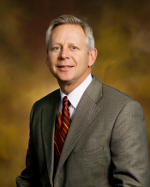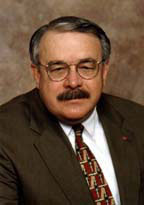Tulsa’s Rick Armstrong (pictured at right) was recently selected chairman of the Oklahoma Aeronautics Commission for the current fiscal year ending  June 30, 2012.
June 30, 2012.
Armstrong will head the seven-member board responsible for encouraging, fostering and assisting in the development of aviation in Oklahoma. This includes the preservation and improvement of the Oklahoma Airport System and promotion of the state’s top employer—the aerospace industry.
Elected to the Commission for the first time are Dr. David Conway of Durant, vice chairman; and Joe Harris of Blackwell, secretary.
The remaining members of the Aeronautics Commission include Wes Stucky of Ardmore, who served as chairman this past fiscal year; Dave Amis III and Tom Stephenson, both of Oklahoma City; and Michael Ray of Guymon.
Armstrong, since April 2007, has served as vice president of FlightSafety International Simulation in Broken Arrow, Okla., where he is responsible for the development, manufacture and certification of flight simulators for military and commercial aviation markets. He manages FlightSafety facilities in Tulsa; Austin, Texas; and St. Louis, Mo.
Prior to joining FlightSafety International, Armstrong worked 18 years for The NORDAM Group in Tulsa where he served as vice president for the Interiors and Structures Division and Transparency Division. His employment background also includes eight years with Xerox Corporation.
Armstrong also serves on the executive board of the Oklahoma Aerospace Alliance and the Northeastern State University President’s Council as well as boards of directors for both the Broken Arrow Chamber of Commerce and American Heart Association. He is past president of the Tulsa Chapter of the Cystic Fibrosis Foundation. Armstrong holds a bachelor’s degree in business administration and marketing from Oklahoma State University.
Conway (pictured at right) is employed by Southeastern Oklahoma State University in Durant where he serves as director of the school’s Aviation  Sciences Institute. Previously, he served as chair of the Aerospace Department and has been a member of the SOSU faculty since 1998. In 2003 he received SOSU’s Faculty Senate Award for Excellence in Service.
Sciences Institute. Previously, he served as chair of the Aerospace Department and has been a member of the SOSU faculty since 1998. In 2003 he received SOSU’s Faculty Senate Award for Excellence in Service.
An avid pilot who holds commercial, instrument, CFI and multiengine ratings, Conway retired as a command pilot from the United States Air Force where he served as an instructor pilot and evaluator pilot in the Cessna T-37 and Boeing KC-135. He is also one of a handful of flight-rated aerospace physiologists.
Conway earned his Bachelor of Science at Texas A&M – Commerce, Master of Science at the University of Southern California and Doctorate of Education from Oklahoma State University, Stillwater, and has completed coursework in human factors and physiology at specialized schools across the country, including OSU’s College of Osteopathic Medicine. He has had numerous articles published in various journals and magazines focusing on human factors in aviation. In addition, Conway recently completed three programs at Harvard University: The Art of Discussion Leadership, Management & Leadership in Education, and Crisis Leadership, as well as a fellowship in Higher Education Management at Vanderbilt University.
Harris, (pictured lower right) who previously served as chairman in 2008-09 during his first term on the Aeronautics Commission, has been general manager and chief executive officer of Kay Electric Cooperative for the past 22 years. Prior to his work for the electric cooperative, he served as director of Legislative and Regulatory Affairs for the Oklahoma Association of Electric Cooperatives from 1984 to 1989. He also served as assistant director for the Public Utility Division and director of Energy Conservation Services Division for the Oklahoma Corporation Commission from 1981 to 1984.
Harris’ professional affiliations include serving as chairman of the board for the National Information Solutions Cooperative in St.  Charles, Mo., and director of the Energy Co-Opportunity, Inc. Board of Directors in Washington, D.C. He also served for 10 years as chairman of the Blackwell-Tonkawa Airport Trust Authority and as a member of the Authority for 16 years. He is a member of the Airplane Owners and Pilots Association, Experimental Aircraft Association and Antique Airplane Association.
Charles, Mo., and director of the Energy Co-Opportunity, Inc. Board of Directors in Washington, D.C. He also served for 10 years as chairman of the Blackwell-Tonkawa Airport Trust Authority and as a member of the Authority for 16 years. He is a member of the Airplane Owners and Pilots Association, Experimental Aircraft Association and Antique Airplane Association.
A licensed pilot for 35 years and whose hobbies include restoring antique airplanes, Harris earned a bachelor’s degree in environmental science and industrial arts from East Central University in Ada.
Oklahoma’s aviation and aerospace industry is one of the state’s largest employers, resulting in approximately 144,000 jobs statewide. The industry yields an annual industrial output of $12.5 billion and generates an annual payroll of $5 billion. One in 11 Oklahomans derive their income from the aviation and aerospace industry with an average salary of nearly $55,000 compared to about $30,000 for the average Oklahoman.
Oklahoma is also one of seven centers in the world for the modification, maintenance, repair and overhaul of aircraft, boasting the world’s largest military aircraft repair facility, Tinker Air Force Base, and the world’s largest commercial aircraft repair facility, the American Airlines Engineering Maintenance and Engineering Center in Tulsa.
In addition, Oklahoma has 113 publicly owned airports, placing it fourth nationally for the number of public airports per capita. A total of 42 of those airports are jet capable, meaning their runways are at least 5,000 feet long, the minimum distance needed by most jet aircraft to safely land or take off. Approximately 93 percent of the state’s population lives within 25 miles of an airport with a jet-capable runway.



